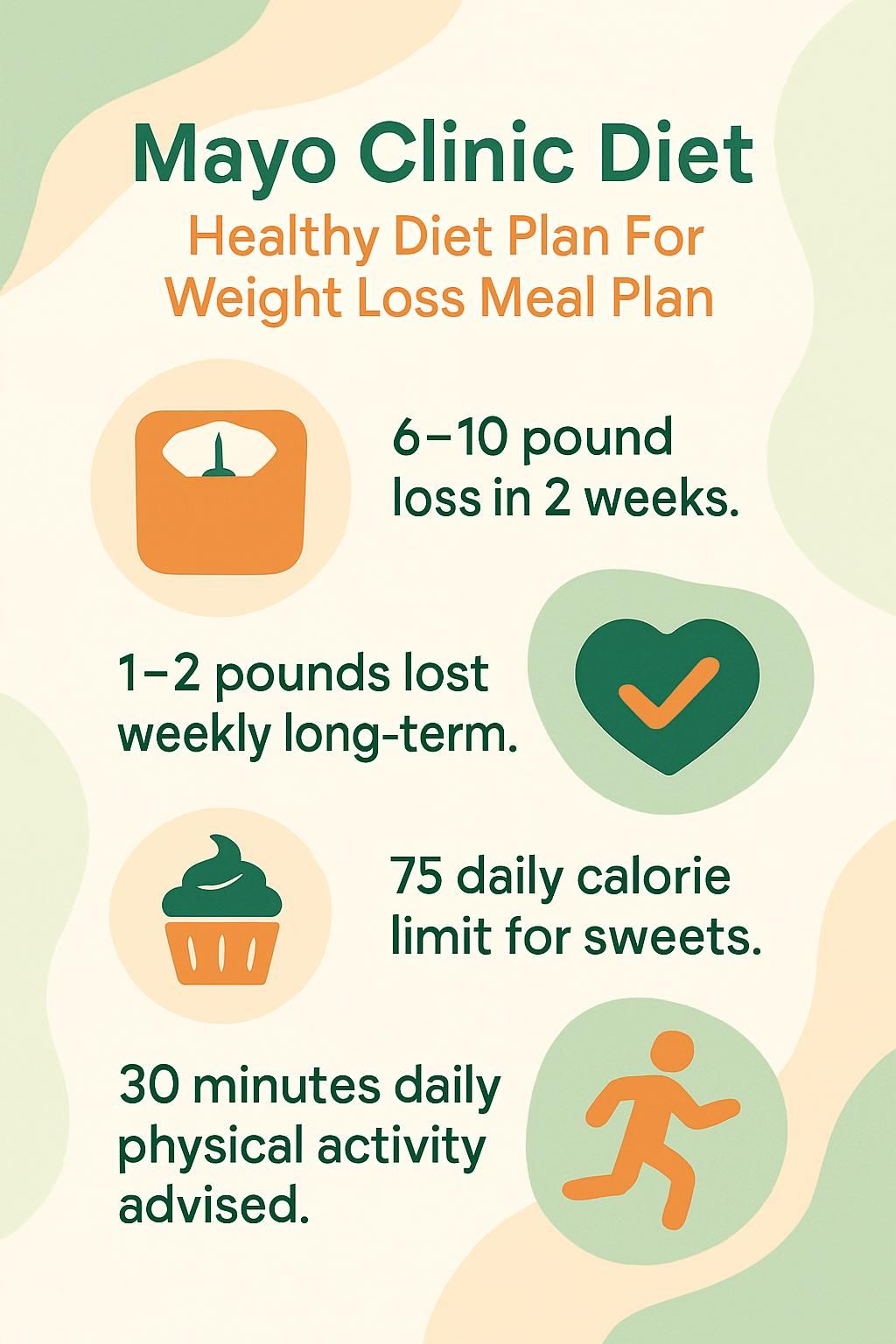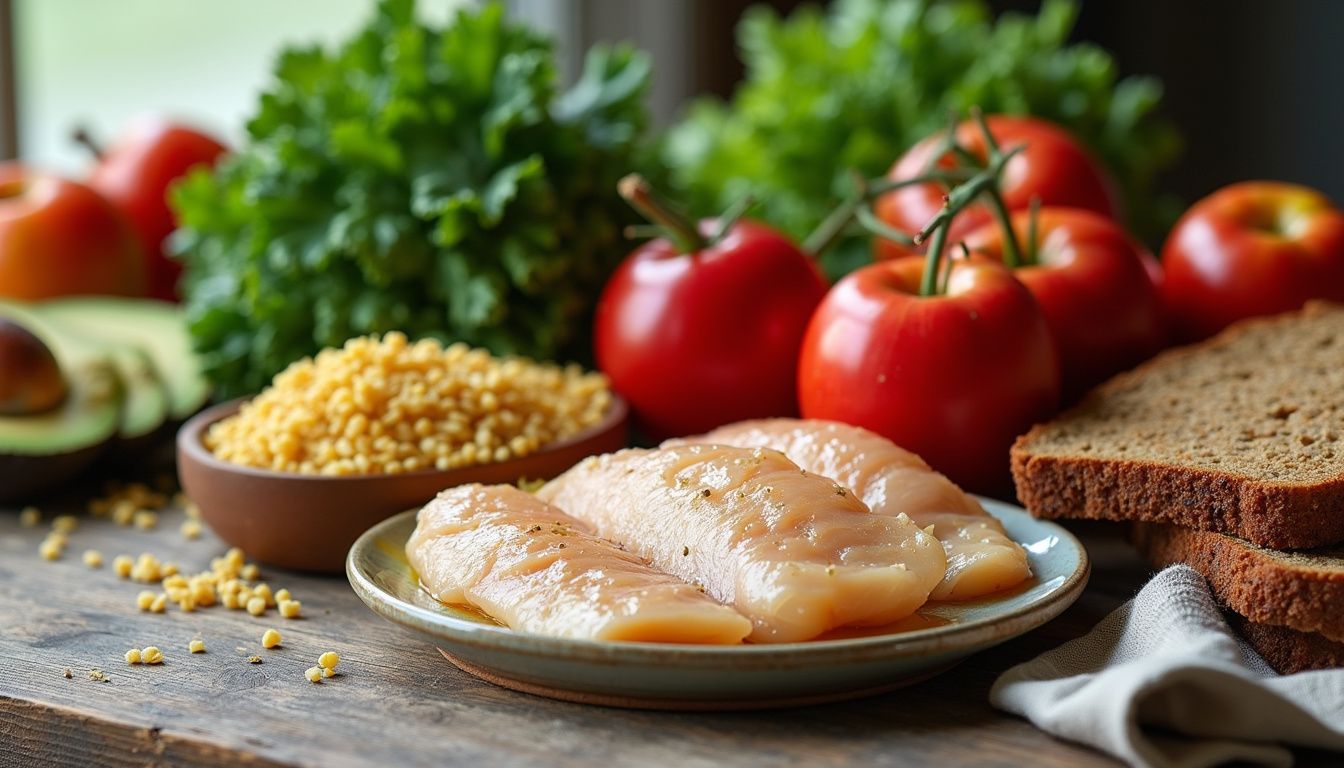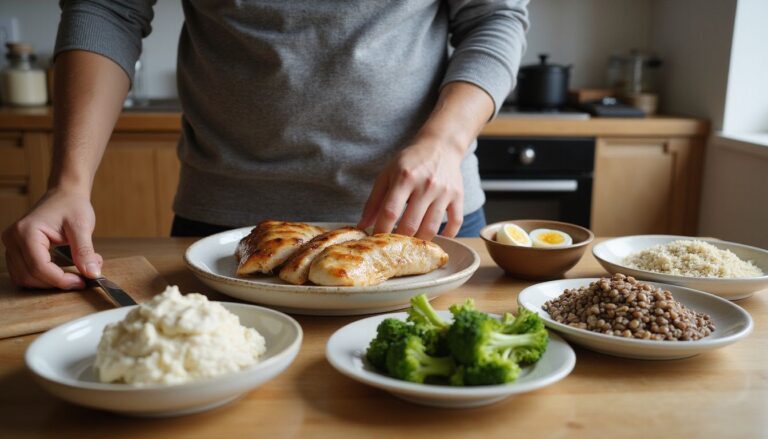Mayo Clinic Diet: Healthy Diet Plan For Weight Loss Meal Plan
Our Nutrition Assistant AI Suite will transform your body. You will lose fat, get toned, and build muscle. Gain confidence and optimal health.
You may feel stuck when diets fail. The Mayo Clinic Diet offers a clear, research-based path that makes healthy eating more practical. This eating plan teaches daily habits that help with weight loss and better health, and it includes a simple meal plan you can start today.
This guide explains how the Mayo Clinic Diet works, what to eat, and how to build meals that taste good and support steady progress. You will learn tools that make change easier and more consistent.
Key Takeaways
- The Mayo Clinic Diet uses two phases, LOSE IT! for two weeks with an average 6 to 10 pound start, then LIVE IT! aiming for 1 to 2 pounds per week, to support long-term weight management guided by Mayo Clinic experts.
- The plan centers on fruits and vegetables, lean proteins like fish or skinless poultry, whole grains, low-fat dairy, beans, and nuts, while limiting sweets to about 75 calories per day.
- The Healthy Weight Pyramid steers your choices toward high fiber, nutrient-dense foods without strict calorie counting. Portion control uses simple visuals instead of math.
- Evidence from sources such as Dietary Guidelines for Americans 2020 to 2025 links this approach to lower risks for heart disease, type 2 diabetes, high cholesterol, and high blood pressure.
- Daily physical activity of at least 30 minutes is encouraged, and the meal plan can fit plant-based or Mediterranean styles through the Mayo Clinic digital tools.

Overview of the Mayo Clinic Diet Plan

The Mayo Clinic Diet is a simple, evidence-based eating plan for healthy eating and weight loss. You can follow it with or without the app, and you get online tools for meal planning, food journaling, and tracking activity.
What is the Mayo Clinic Diet?
Developed by Mayo Clinic medical professionals, this diet focuses on building habits you can maintain for life. It does not promise quick fixes. It teaches skills for steady weight loss and better health over time.
The program supports different food preferences. You can follow a plant-based style, a Mediterranean pattern, or a vegetarian approach, and still meet your nutrition goals. You can also enjoy unlimited fruits and vegetables as part of your daily meals.
This diet made me enjoy raw veggies with every meal,
a friend told me after a month using the app. Next, see the core principles that shape those lasting habits.
What are the main principles of the Mayo Clinic Diet?
The plan helps you build lifelong habits that support weight control and reduce risks from conditions like heart disease and diabetes. The emphasis is on fruits, vegetables, whole grains, beans, lean protein such as fish or skinless poultry, and low-fat dairy like nonfat yogurt.
The Healthy Weight Pyramid places fruits and vegetables at the base. You do not cut entire food groups or count every calorie. Instead, you use simple portion visuals and reasonable serving sizes.
You create personal goals, then practice small changes, such as choosing water over sugar-sweetened drinks. Meal planning keeps food satisfying and nutritious with ideas like veggie burgers, salads with olive oil, grilled fish, a handful of almonds, and fruit-based desserts.
How does the diet help build long-term healthy eating habits?
You learn to choose foods that are high in fiber and lower in calories, then match them to smart portions. Over time, these choices can lower high blood pressure and improve blood sugar control.
The plan encourages regular physical activity, plus menu planning that makes healthy meals simple. It uses two phases, LOSE IT! and LIVE IT!, to support steady change rather than strict rules.
With strategies from Mayo Clinic experts, you replace high-sugar or high-fat habits with routines that better fit your goals. Many people see improvements in cholesterol and heart health as they stay consistent.
Benefits of the Mayo Clinic Diet
This diet highlights nutritious foods that support weight loss and overall health. The approach is preventive, meaning it helps reduce disease risk while improving daily energy.
How does expert medical support enhance this diet?
Access to Mayo Clinic weight-loss and nutrition experts helps you make safer choices. Their guidance can align calorie levels, food types, and portions with your health history.
Advice follows respected sources, including Dietary Guidelines for Americans 2020 to 2025. You can also use tools like a BMI calculator and customized food lists that adjust for sodium, saturated fat, and other needs.
Doctors and registered dietitians can tailor your plan if you have diabetes, high blood pressure, or digestive issues. They can also match recipes to your needs, such as lean meat, quinoa, cottage cheese for breakfast, or Mediterranean-style meals that may help reduce inflammation and support brain health.
Source: Hensrud DD, et al., Mayo Clinic Guide to Healthy Weight Management, 2017; Dietary Guidelines for Americans 2020 to 2025.
Why is sustainable weight management important in this diet?
Sustainable weight management lowers the chance of regain. The LIVE IT! phase sets a steady pace of about 1 to 2 pounds per week, which is easier to maintain.
With a balanced diet that includes fruits, vegetables, whole grains like oats or rice, and lean protein such as eggs or chicken, your energy and blood sugar can stay more stable. I once tried crash diets and felt worn out. Switching to a Mediterranean-style pattern with leafy greens and nuts helped me keep a steady waistline and better energy through the year.
Mayo Clinic experts favor this approach because it teaches skills for setbacks and planning ahead. That lowers the risk of sliding back into old habits.
How does the diet improve overall health?
Better weight management can improve many health markers. A diet rich in vegetables, fruits, whole grains, and healthy fats often lowers blood sugar and improves cholesterol.
People on similar eating patterns see drops in blood pressure and lower risk of heart attack or stroke. Daily physical activity of at least 30 minutes is part of the plan and adds to these benefits.
When I replaced processed snacks with a simple couscous salad or a hearty vegetable soup, I felt more energetic. If you lose extra weight, symptoms like sleep apnea may also improve. The Healthy Weight Pyramid helps you plan meals that support results you can keep.
How the Mayo Clinic Diet Works
This plan moves in clear steps, so you know what to do now and what to do next.
What are the Lose It! and Live It! phases?
You start with two phases, each with specific goals for eating and activity. They build the core of your routine.
- Begin with the LOSE IT! phase, a focused two-week start where most people lose 6 to 10 pounds, or about 2.7 to 4.5 kilograms.
- Add five new habits, such as eating breakfast every day, filling half your plate with fruits and vegetables, moving at least 30 minutes daily, using smaller plates, and planning meals in advance.
- Stop five habits, like mindless snacking on sweets, eating while watching TV, drinking sugary beverages, choosing fried foods, and ordering oversized portions at restaurants.
- Practice five bonus habits. For example, keep a food journal and use lower-fat cooking methods like baking or roasting instead of frying.
- Move to the LIVE IT! phase after two weeks. This long-term phase targets a loss of about 1 to 2 pounds weekly.
- Use tracking tools and journals in both phases. They help you measure progress and stay accountable.
- Build skills for a Mediterranean-style pattern. Choose nuts, whole grains, seafood, low-fat dairy, and lean proteins like roasted chicken breast.
- Follow the Healthy Weight Pyramid to manage calories while limiting saturated fat. Choose complex carbs, such as oats and brown rice, more often than refined options.
- Keep active. Aim for at least 150 minutes of movement per week to support heart health and energy.
- Talk with a registered dietitian if you have unique medical needs. Expert guidance helps you reach goals safely.
These steps come from Mayo Clinic medical guidance and support steady, realistic change.
How can you cultivate healthy eating and lifestyle habits?
Start small. Simple actions add up when you repeat them daily. The Mayo Clinic Diet gives you a structure that supports consistency.
- Swap sugary drinks for water or unsweetened tea. Hydration helps you feel full and supports metabolism.
- Plan meals with the Healthy Weight Pyramid as your guide. Focus on fruits, vegetables, whole grains, beans, nuts, and lean protein.
- Practice the five new LOSE IT! habits in the first two weeks, such as eating breakfast and choosing lower-fat options.
- Measure portions. People who know their serving sizes tend to eat fewer calories.
- Move for at least 30 minutes daily. Brisk walking, cycling, or short bodyweight workouts work well.
- Seek support from a registered dietitian or a group. Support can help you stick with the plan.
- Replace unhelpful habits with bonus behaviors, such as keeping a food diary or adding a vegetable to every meal.
- Eat mindfully. Slow down, notice flavors, and stop when you are satisfied.
- Reduce screen time during meals. Fewer distractions help you notice hunger and fullness cues.
These habits make portion control and calorie awareness easier without complicated math.
How does the diet manage calorie intake and portion sizes?
You do not need to count every calorie. The Healthy Weight Pyramid teaches you how to fill your plate, with fruits and vegetables as the largest share.
Sample daily targets include 1,200, 1,300, 1,400, 1,500, and 1,800 calories. You can include up to about 75 calories of sweets per day, or save some for a weekly treat. This structure helps keep meals balanced with less effort.
Essential Components of the Mayo Clinic Diet
These building blocks make the plan easy to follow and flexible for your life.
What is the Healthy Weight Pyramid?
The Healthy Weight Pyramid is your daily guide. Fruits and vegetables make up the base, so you eat more of them. Whole grains and lean proteins form the middle, and sweets and added fats sit at the top, which means you use them sparingly.
This visual helps you balance meals for weight loss and health. It reflects Mayo Clinic’s evidence-based program described in The Mayo Clinic Diabetes Diet, 2nd edition, 2018.
Which nutrient-dense foods should you choose?
Nutrient-dense foods give you more vitamins, minerals, fiber, and protein for fewer calories. They help control hunger and support steady energy.
- Fruits such as oranges, berries, apples, and melons for vitamins and fiber.
- Vegetables at every meal. Leafy greens like spinach and kale support heart health.
- Whole grains like brown rice, quinoa, oats, and whole-grain bread for longer-lasting energy.
- Lean proteins, including fish, skinless poultry, beans, tofu, and eggs for muscle support.
- Nuts and seeds, such as almonds and sunflower seeds, for healthy fats and fullness.
- Beans and lentils for fiber and plant-based protein that supports digestion.
- Healthy fats like olive oil and avocado to improve vitamin absorption.
Including these foods each day supports weight loss and better nutrition.
How does physical activity fit into the diet?
Movement is a partner to healthy eating. It helps with weight loss and also protects your heart, lungs, and mood.
Aim for at least 30 minutes a day. Add more if you can. Some days I take a brisk walk. Other days I follow a short beginner workout video to stay motivated.
The plan adapts to your fitness level, so you can start where you are and build up over time.
Advantages of Following the Mayo Clinic Diet
This plan supports weight loss and better health without extreme rules. You practice habits that fit real life.
How does the diet support weight loss and maintenance?
The two phases encourage steady progress. In LOSE IT!, many people lose 6 to 10 pounds in two weeks. In LIVE IT!, weight loss usually continues at about 1 to 2 pounds a week.
Portion control keeps calories in check while you still enjoy nutrient-rich foods like fruits and vegetables. Calorie levels are flexible based on age, sex, and activity. These skills help you keep weight off after you reach your goal.
How does it reduce risks for heart disease and diabetes?
Eating more fruits, vegetables, beans, and whole grains supports healthy blood pressure and blood sugar. The plan limits unhealthy fats and encourages healthier fats from olive oil, nuts, and fish.
Research reviewed by the U.S. Preventive Services Task Force links produce-rich diets with lower blood pressure and reduced risk for diabetes and heart disease. Even modest weight loss decreases risk tied to sleep apnea, unhealthy cholesterol, and insulin resistance.
The American Cancer Society also supports these eating patterns for lowering the risk of several chronic diseases.
In what ways does it boost energy and overall health?
Balanced meals with fiber, protein, and healthy fats give you steady energy instead of highs and lows. A 2023 nutrition study found that higher fiber intake was linked with better daily energy.
A variety of colorful produce supports your immune system and brain function. Regular activity, which this plan encourages, can also improve focus and mood. When I added a serving of fresh oranges at breakfast, I noticed clearer thinking during the workday.
One-Week Weight Loss Meal Plan
Use this one-week meal plan as a starting point. Adjust portions to your calorie target and preferences.
What does Day 1’s balanced meals look like?
- Breakfast: 3/4 cup bran flakes, one banana, and one cup fat-free milk for fiber, potassium, and calcium.
- Lunch: Mini whole-wheat pita with 3 ounces turkey breast, half a roasted pepper, 1 teaspoon mayo, mustard, lettuce, and one mozzarella string cheese. Add two kiwis.
- Dinner: Four ounces flounder, one cup cooked couscous, and one cup steamed broccoli.
- Dessert: One single-serve ice cream within your calorie plan.
- Portion tip: Lean proteins and fruit, such as turkey and banana, help meet nutrition needs without extra calories.
- Plant-based swap: Try a veggie niçoise pita, about 290 calories, if you prefer a vegetarian lunch.
What fiber-rich, protein-focused, and plant-based meals are planned for Day 2?
- Breakfast: Smoothie with one cup frozen berries, half a banana, and eight ounces low-fat or fat-free milk.
- Optional: Two hard-boiled eggs for extra protein. Add an orange for vitamin C and fiber.
- Lunch: One cup vegetable soup and a mushroom-quinoa burger on whole-grain toast.
- Snack: One cup grapes for hydration and natural sweetness.
- Dinner: Barbecue-style cutlets, about 265 calories per serving, plus citrus slaw or sautéed spinach with garlic and tomatoes.
- Side: One baked potato for fiber-rich complex carbs.
- Focus: Keep meals colorful with leafy greens, legumes, whole grains, and fruit.
These choices support fullness, steady energy, and a satisfying eating style.
What low-calorie, lean protein, and seafood meals are included on Day 3?
- Breakfast: Half cup oats cooked in low-fat or soy milk. Add half an apple, one teaspoon honey, and cinnamon.
- Snack: One orange for hydration and vitamin C.
- Lunch: Four ounces shredded chicken mixed with a quarter cup grapes, one tablespoon chopped nuts, celery, light mayo, and Greek yogurt. Serve over lettuce with multigrain toast.
- Snack: Raw veggies with two tablespoons hummus.
- Dinner: Four ounces steamed shrimp and a baked potato topped with salsa and Greek yogurt. Add three cups steamed spinach.
- Dessert: One ounce chocolate or a 100 to 150 calorie ice cream bar.
- Hydration: Drink water throughout the day to help manage hunger.
These meals support muscle repair, fullness, and flavor without extra calories.
What whole grains, salads, and vegetarian options are on Day 4?
- Breakfast: Cooked quinoa or oatmeal topped with sliced bananas and a sprinkle of chia seeds.
- Lunch: Spinach salad with chickpeas, shredded carrots, cherry tomatoes, and a light vinaigrette.
- Whole-grain side: One cup brown rice or barley at lunch or dinner.
- Snack: Greek yogurt with one cup berries for protein and probiotics.
- Soup: Lentil, tomato, onion, and garlic soup for plant-based protein.
- Dinner: Zucchini noodles or whole-wheat pasta with grilled peppers and asparagus, finished with a drizzle of olive oil.
- Evening snack: Baby carrots with 1/4 cup hummus.
When I added more quinoa dinners, I stayed full later into the evening without extra snacking.
What protein-intensive, light soups, and grilled dishes are planned for Day 5?
- Breakfast: Greek yogurt, 6 ounces, with half cup berries, one tablespoon slivered almonds, and one cup Cheerios.
- Lunch: Mushroom quesadillas in about 25 minutes. Add cucumber spears and half cup cottage cheese or Greek yogurt.
- Snack: Two clementines for a quick vitamin boost.
- Dinner: Pork tenderloin grilled with balsamic, honey, and thyme, about 370 calories per serving.
- Starter: Light soups like chicken vegetable or tomato basil without cream to help control sodium and calories.
- Snack: Cut vegetables with hummus for a fiber and protein boost.
- Seafood option: Grilled salmon or cod once this week for omega-3 fats.
For me, the mix of yogurt, cottage cheese, pork tenderloin, and seafood kept me satisfied much longer than carb-heavy meals.
What fruit-centric, low-carb, and Mediterranean meals are on Day 6?
- Breakfast: Greek yogurt with mixed berries and ground flaxseed. Add a small banana for potassium.
- Snack: Apple with two tablespoons almond butter for healthy fats and fiber.
- Lunch: Mediterranean salad with mixed greens, tomatoes, cucumbers, olives, feta, and grilled chicken. Dress with extra-virgin olive oil and lemon juice.
- Snack: One cup sliced cantaloupe or watermelon for hydration.
- Dinner: Grilled salmon over sautéed spinach with garlic in one tablespoon olive oil. Add roasted eggplant slices.
- Hydration: Aim for about eight cups of water daily.
- Carb swap: Choose leafy vegetables instead of bread or pasta at meals.
- Evening drink: Herbal tea or fat-free milk to round out the day near a 1,200 calorie goal if that fits your plan.
These choices highlight fruit, healthy fats, seafood, and plenty of non-starchy vegetables.
What smoothies, balanced dishes, and vegetable-focused dinners are included on Day 7?
- Breakfast smoothie: Spinach, frozen berries, Greek yogurt, and flaxseed for protein and fiber.
- Mini breakfast plate: Half an English muffin with one ounce reduced-fat cheese and sliced tomato, plus one cup steamed spinach and a poached egg. Add half a grapefruit.
- Lunch: Black bean salad with orange segments, diced peppers, onions, scallions, and one teaspoon vinegar. Serve over greens with a corn tortilla.
- Portion cue: Measure servings to stay within your calorie range.
- Snack or starter: Light vegetable soup or minestrone for extra fiber.
- Dinner vegetables: Grilled zucchini or eggplant to add flavor without excess sodium or fat.
- Balanced plate: Roasted chicken breast or baked tofu with steamed broccoli and brown rice.
Each meal supports portion control and steady weight loss using the Mayo Clinic Diet guidelines.
How to Maintain the Mayo Clinic Diet Long-Term
Lasting success comes from routines that fit your life. Plan ahead, stay hydrated, and keep moving.
How can meal planning help maintain the diet?
Meal planning keeps your week on track. You build balanced plates and reduce last-minute choices that push you off plan.
Add vegetables to meals and keep fruit for snacks. Rotate recipes so you enjoy variety without extra work. Adjust protein portions to match hunger. For example, adding about 15 ounces of protein across a week helped me avoid late-night cravings.
Tracking makes portion control easier and helps you manage calories without feeling deprived.
Why is hydration and mindful eating important?
Mindful eating means paying attention to hunger, fullness, and flavor. It helps you enjoy food and reduce overeating.
Water-rich foods like fruits and vegetables support hydration while adding fiber and vitamins. The plan allows unlimited amounts of these foods, which makes portions easier to manage.
Choices such as watermelon and cucumbers hydrate you and support digestion. Pair them with regular activity for better results.
How often should you include physical exercise?
Aim for at least 30 minutes of activity every day. Walking, biking, swimming, or any activity that raises your heart rate counts.
Both LOSE IT! and LIVE IT! encourage daily movement because it helps with weight control and mental health. People who move regularly tend to keep weight off more effectively.
Schedule workouts and add short bursts of activity throughout your day. Small steps build confidence and momentum.
What Results Can You Expect from the Mayo Clinic Diet?
With steady effort, you can expect gradual weight loss, better energy, and improvements in key health markers.
How does the diet promote gradual and sustainable weight loss?
The plan uses two phases to set a realistic pace. LOSE IT! often leads to a 6 to 10 pound drop in two weeks. LIVE IT! continues at about 1 to 2 pounds per week until you reach your goal.
You will learn planning, portion control, and regular activity. These become daily habits rather than a short-term fix. I found that these simple steps made it easier to keep the weight off while still enjoying favorite foods in moderation.
Research shows that slower, steady loss is easier to maintain compared with extreme diets.
Which health markers improve, like cholesterol and blood pressure?
As weight comes down, LDL cholesterol often decreases and HDL can improve. Even a 3 to 5 percent weight reduction can help lower blood pressure.
Triglycerides and glucose may decrease as well. These changes reduce the risk of type 2 diabetes and heart disease. In my case, losing five pounds led to better results at my next annual visit.
Doctors see these benefits across many age groups when people follow a structured, healthy eating plan for several months.
How does the diet enhance self-confidence and healthier habits?
Seeing progress builds motivation. Making informed food choices gives you a sense of control. You learn to handle slip-ups and return to your plan quickly.
Electronic tools help you set goals and track them. As your energy and mood improve, healthy routines feel more rewarding and easier to keep.
Important Considerations and Risks of the Mayo Clinic Diet
This plan is suitable for many people, but health conditions can require changes. A healthcare professional can help you adapt it safely.
When should you consult healthcare professionals before starting?
Talk with a healthcare provider before you start, especially if you have diabetes, heart disease, hypertension, or another condition. Some medications interact with certain foods or require timing adjustments.
Mayo Clinic suggests using a BMI calculator to estimate weight status, but only a clinician can interpret results for children. My doctor reviewed my labs and adjusted my plan because of my high blood pressure. That made the process safer for me.
Children’s BMI requires age and sex growth charts that trained providers use. If you take prescriptions, check with your clinician or a registered dietitian first.
How can the diet be customized for individual health needs?
Your calorie target should match your health profile. If 1,200 feels too low, options like 1,300, 1,400, 1,500, or 1,800 may fit better.
My doctor suggested 1,500 calories due to past low blood sugar. That change supported steady weight loss and stable energy at work. People with diabetes may swap some fruit snacks for vegetables to manage blood sugar.
Adding more fiber from beans and whole grains can cause gas at first. Increase fiber gradually and drink water to ease discomfort. Higher fruit intake early on may raise blood sugar briefly, but this usually improves as weight drops and insulin sensitivity improves.
Medical disclaimer: This article is for education only and is not a substitute for personal medical advice. Consult a qualified professional for diagnosis and care.
Conclusion
The Mayo Clinic Diet gives you a practical meal plan and daily habits that support healthy weight loss. You learn portion control, smart food choices, and regular activity without strict rules. Evidence suggests benefits for weight, cholesterol, and blood pressure.
The plan is flexible, so you can build meals that match your tastes. With steady effort, you can gain confidence as your health improves. If you want a reliable, science-based path to a healthy diet and lasting habits, this eating plan is a strong choice.
FAQs
1. What is the Mayo Clinic Diet and how does it support weight loss?
The Mayo Clinic Diet is a structured eating plan developed by medical experts at a leading health institution. It focuses on healthy food choices, portion control, and regular physical activity. Studies show that following this diet can help people lose 6 to 10 pounds in the first two weeks, then about 1 to 2 pounds each week after that (Mayo Foundation for Medical Education and Research). The plan emphasizes fruits, vegetables, whole grains, lean proteins like poultry or fish, and limits added sugars.
2. How does the meal plan work within the Mayo Clinic Diet?
This meal plan uses balanced meals with specific calorie targets based on individual needs. A typical day may include three main meals plus snacks from approved food groups such as fresh produce or low-fat dairy products. For example:
– Breakfast: Oatmeal with berries
– Lunch: Grilled chicken salad
– Snack: Greek yogurt
– Dinner: Baked salmon with steamed broccoli
Nutritional content per day often ranges between 1,200 to 1,600 calories for most adults aiming for weight loss.
3. Is there scientific evidence supporting the effectiveness of this diet?
Yes; clinical studies published by respected organizations confirm that diets rich in plant-based foods and low in processed items promote steady weight reduction and better heart health (Harvard T.H. Chan School of Public Health). The Mayo Clinic’s approach aligns with these findings through its focus on nutrient-dense foods.
4. Can you share a personal experience applying this healthy eating pattern?
After adopting this dietary approach last year under my doctor’s guidance, I noticed improved energy levels within weeks while losing eight pounds during the initial phase. Planning meals ahead made grocery shopping easier; sticking to recommended servings helped me avoid overeating at social events.
Summary:
The Mayo Clinic Diet offers an evidence-based path toward sustainable weight management using practical meal plans centered around nutritious ingredients like vegetables and lean meats. Clinical data supports its benefits for both short-term results and long-term wellness when combined with consistent lifestyle habits such as daily exercise.







